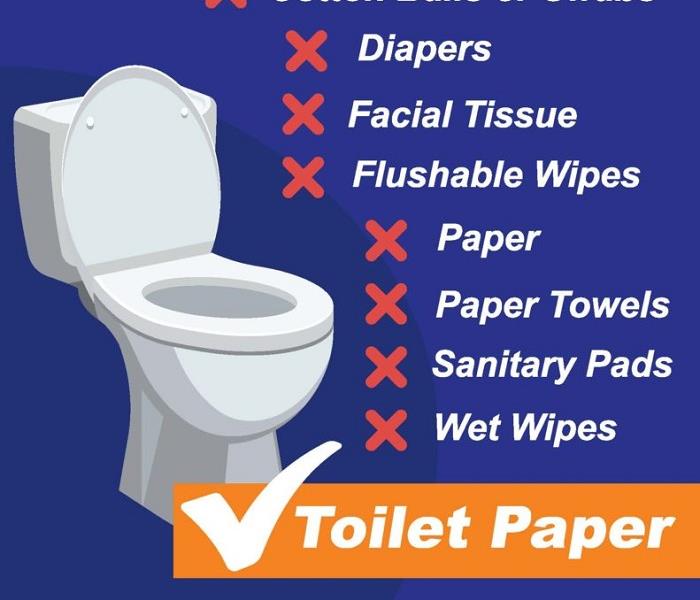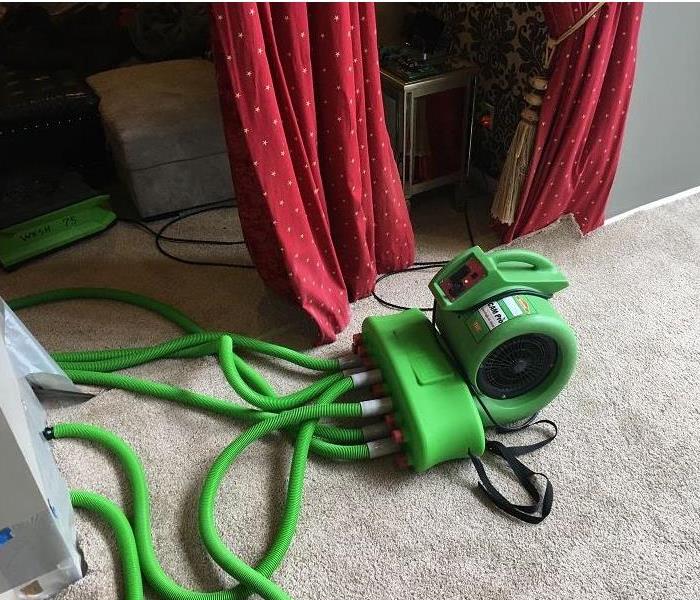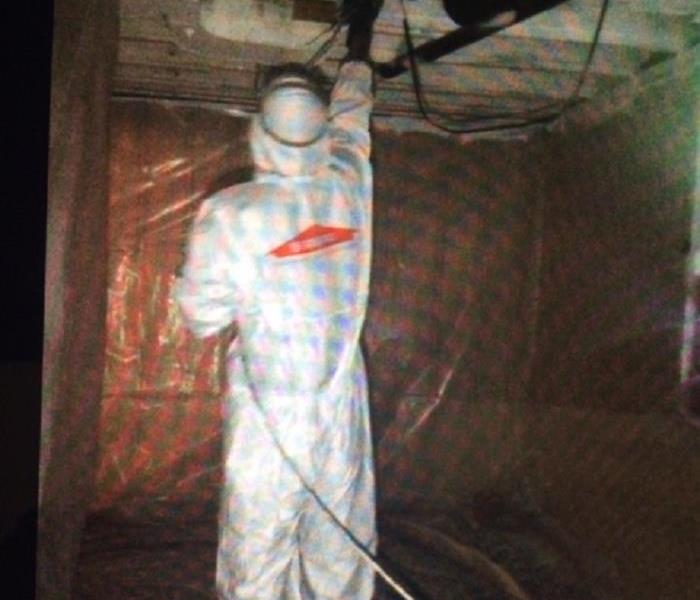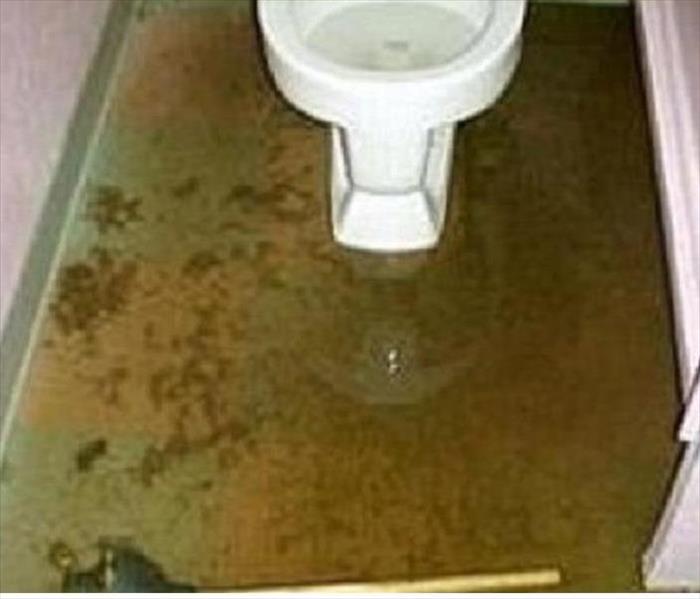Recent Water Damage Posts
How to Deal With Commercial Water Damage to Your Business | SERVPRO® of West Kirkwood/Sunset Hills
8/11/2023 (Permalink)
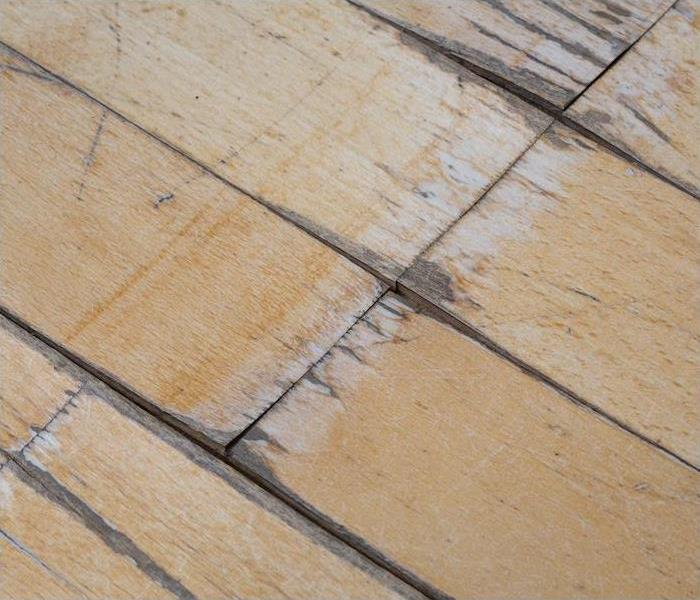 SERVPRO of West Kirkwood/Sunset Hills is your local commercial water restoration company. We will always be here to help and get you back in business.
SERVPRO of West Kirkwood/Sunset Hills is your local commercial water restoration company. We will always be here to help and get you back in business.
When commercial water damage affects your building, the impact on business can be severe.
Many sources of flooding come from internal sources. Burst pipes or a badly leaking roof can shut you down or ruin interiors and destroy inventory. Damage might also come from a bathroom flooded with sewage backup. Or it could even be an entire floor of offices soaked by a broken sprinkler system.
However, water damage can also affect businesses through natural causes. In Sunset Hills, businesses are at risk of water from heavy rainfall, snowmelt, rising water levels and broken dams.
Because all of these sources are unpredictable, it is best to determine how vulnerable your building is depending on its location before these disasters strike our area.
Knowing what to do before disaster strikes make recovering quickly and returning to business easier. Regardless of what source left the water behind, these helpful tips can guide you through handling the problem quickly and as stress-free as possible.
Know Your Building’s Layout
Familiarize yourself with different water cutoff points throughout your property, and ensure you know how to turn off the fire sprinkler system. Locate the main water cutoff valve, and be ready to shut off the entire building’s supply when necessary.
Several people should know this information, including members of the leadership team. This can help you reduce the amount of water that gets inside your business by cutting it off at the source.
Know the Types of Water Involved
When water damage happens, the type of water involved will determine how dangerous the situation is. Knowing what you’re dealing with makes a big difference in the safety of everyone in the building:
White water: This type of water most commonly results from plumbing problems. It’s not considered contaminated and is safe to handle yourself in small amounts.
Gray water: Sink drains and toilet tank overflows produce this type of flooding. The water is contaminated but not considered dangerous.
Black water: Sewage backups and storm flooding are common sources of highly contaminated black water. Always call in a professional to deal with this type of toxic water damage.
Take Action Quickly
Always attempt to identify and shut down the water source as soon as possible. Try to get fresh air circulating by opening windows and doors to expedite the drying and evaporation process. Then alert everyone in the building and outline the affected areas so that no one comes into contact with the water.
After taking these steps, be sure to thoroughly document any visible damage. This will help you speed through the insurance claim process and will be useful when deciding what parts of your building need the most reinforcement.
Remember to Be Patient
The visible water damage in your building is only part of the overall problem. Soaked wall studs, moldy framing and buckled flooring materials are only a few signs of hidden water damage. Any of these indicators should be red flags of potential damage.
If your business experiences water damage, call SERVPRO of West Kirkwood/Sunset Hills for a quick response and a shoulder to lean on. Our restoration professionals have extensive training and will work with industry-leading equipment that can dry your building out and get you back into action fast.
The cleanup and drying process can take up to a week, depending on the extent of the moisture, so be patient as our restoration team works through the cleanup and sanitation before beginning repairs. We’ll have your business back to preloss condition before you know it.
When disaster strikes your commercial property, we’ll be there to help clean up and get you back in business quickly. Call SERVPRO of West Kirkwood/Sunset Hills today at (314) 858-1688.
Dealing With Flood Damage | SERVPRO of West Kirkwood/Sunset Hills
6/28/2023 (Permalink)
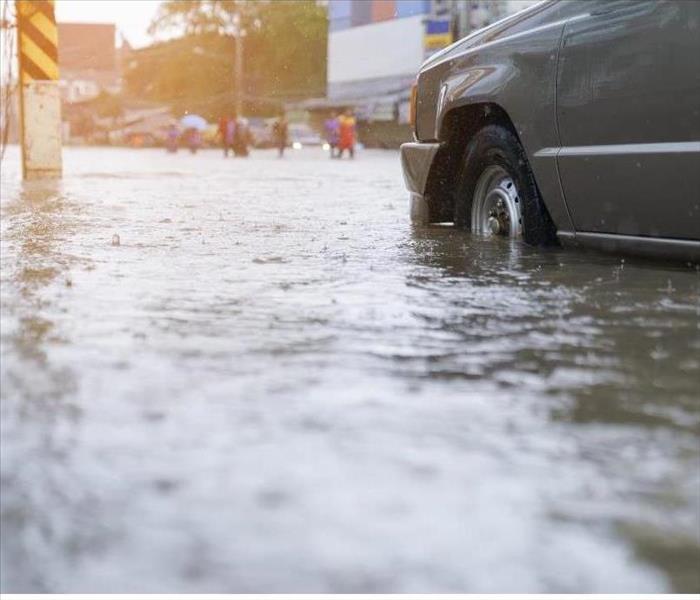 SERVPRO of West Kirkwood/Sunset Hills is here to help with flood damage
SERVPRO of West Kirkwood/Sunset Hills is here to help with flood damage
Floods can be devastating natural disasters, wreaking havoc on homes and properties. Recovering from flood damage requires a well-structured and organized approach to minimize further loss and restore your property to its pre-flood condition. In this article, we will provide you with a comprehensive guide on how to handle flood damage effectively. By following these steps, you can navigate the restoration process more efficiently and ensure the safety and well-being of your home and family.
Step 1: Ensure Safety
Before entering your home or property after a flood, prioritize safety. Ensure that the floodwaters have fully receded and it is safe to return. Be cautious of structural damage and potential electrical hazards. Wear appropriate protective gear such as rubber gloves, boots, and face masks to avoid exposure to contaminants in the water.
Step 2: Document the Damage
Once it is safe to enter your property, thoroughly document the flood damage. Take photographs or videos of all affected areas, including structural damage, personal belongings, and appliances. This documentation will be invaluable for insurance claims and aid in the restoration process.
Step 3: Contact Your Insurance Company
Notify your insurance company about the flood damage as soon as possible. Provide them with all necessary details, including the extent of the damage, photographs, and videos. Understand your insurance policy and coverage to ensure you are aware of what is eligible for compensation.
Step 4: Disconnect Utilities
For safety reasons, turn off the main power supply to your property. Additionally, shut off the gas and water supplies to prevent further damage and potential hazards. Contact the appropriate utility companies if you require assistance with these procedures.
Step 5: Remove Standing Water
Begin by removing any standing water from your property. Use pumps, wet/dry vacuums, or hire professional water extraction services if necessary. Properly dispose of the water to prevent contamination and further damage.
Step 6: Dry and Ventilate the Property
After removing the standing water, it is crucial to dry out your home or property thoroughly. Open windows and doors to promote air circulation, and use dehumidifiers, fans, and heaters to expedite the drying process. Remove wet carpets, furniture, and other items that can harbor moisture.
Step 7: Clean and Disinfect
Floodwaters can introduce harmful contaminants and pathogens to your home. Clean and disinfect all affected surfaces, including walls, floors, and furniture. Use appropriate cleaning agents, wear protective gear, and follow manufacturer instructions for effective disinfection.
Step 8: Remove Damaged Materials
Inspect your property for damaged materials that need to be removed. This may include drywall, insulation, flooring, and furniture. Discard damaged items properly, following local regulations, and keep a detailed inventory of all disposed of belongings for insurance purposes.
Step 9: Repair and Restore
With the damaged materials removed, assess the structural integrity of your property. Repair any structural damage, including walls, floors, and roofs, with the help of professionals if necessary. Ensure that repairs comply with building codes and regulations.
Step 10: Seek Professional Assistance
Depending on the severity of the flood damage, you may need to engage professional restoration services. Experienced flood damage restoration companies, like SERVPRO of West Kirkwood/Sunset Hills, can provide expertise and specialized equipment to expedite the restoration process and mitigate further damage.
Step 11: Evaluate and Enhance Future Protection
As you restore your property, take the opportunity to evaluate your flood protection measures. Consider implementing strategies such as installing flood barriers, elevating electrical systems, sealing foundation cracks, and landscaping changes to divert water away from your property. Consult with experts or local authorities for guidance on flood mitigation.
Protect Your Home From Water Damage | SERVPRO of West Kirkwood/Sunset Hills
5/24/2023 (Permalink)
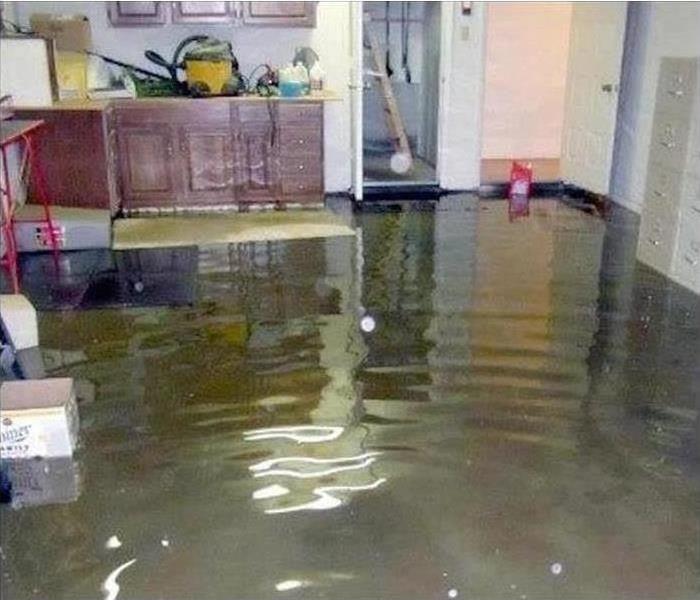 Call SERVPRO of West Kirkwood/Sunset Hills for water damage restoration.
Call SERVPRO of West Kirkwood/Sunset Hills for water damage restoration.
There are many ways to help protect your West Kirkwood/Sunset Hills home from water damage. Water losses occur when water finds its way outside of the appliances you rely on to run your household’s daily needs. When we think about the causes of severe water damage to our homes, we usually think about extreme weather like a hurricane or torrential rains. But the unfortunate reality is that extensive damage is often the result of ordinary household plumbing systems and appliances that fail – and these can be just as destructive to your home as an extreme weather event.
Preventative Measures
Fortunately, there are steps that you can take to help prevent water damage from plumbing problem in your West Kirkwood/Sunset Hills home. It is helpful to understand some of the common causes of water damage.
These may include:
• Heating and air-conditioning systems
• Water heaters
• Valves
• Appliances
• Pipes and plumbing fixtures
How to Detect Water Damages
Water damage can often go undetected, even if the telltale signs are there. Plumbing that is housed inside the walls of your home, in less-trafficked areas like a basement or attic, or behind a cabinet or appliance, can easily go unnoticed. That’s why it’s important to check your appliances and plumbing from time to time.
- Know where the main water supply enters your home, locate the main shut-off valve and make sure it’s functioning properly.
- If you will be away from home for an extended period, consider shutting off the water supply, but consult with a heating professional first to understand if doing so will compromise any other systems in your home. Maintain a temperature of at least 55 degrees in your home. Also, if your home is protected by a fire sprinkler system, do not turn off the water to this system, and maintain sufficient heat to prevent a freeze-up.
- Consider having your air-conditioning system inspected regularly by a professional. Check around the unit for indications of leaks. Check the drain lines annually and clean them if they are clogged. Change the air filter annually at a minimum.
- Inspect water heaters, showers, tubs, toilets, sinks, dishwashers, refrigerators and washing machines annually, and have them repaired if there are signs of leaks or corrosion. Be sure to include supply lines, hoses, connections and fittings in the inspection.
- Check caulking around showers, bathtubs, sinks and toilet bases, and make repairs as needed.
- If your refrigerator has an ice machine or water dispenser, check the hose between the wall and the refrigerator to determine if it is pinched or stressed. Also look for signs of leaking or wear and tear.
- Check exposed plumbing (pipes, valves, etc.) for signs of leaking or corrosion. Have any pipe damage fixed immediately to prevent more costly repairs in the future.
For any questions or concerns about water damage in your home, call SERVPRO of West Kirkwood/Sunset Hills at (314) 858-1688.
Water damage due to a plumbing issue in your home can be life-changing. But there are some common signs that homeowners can look for, and steps they can take, to help avoid a major water issue at home.
Consider this example:
A homeowner and his family head off for a three-week vacation. While they’re away, a minor toilet leak grows, until it reaches a pace of three gallons of water per minute. By the time the homeowners returned from their three-week vacation, the unaddressed leak had poured more than 30,000 gallons of water into their home. The water ruined furniture, fixtures and irreplaceable family valuables, and rendered the property virtually uninhabitable for an extended period of time.
But this is just a cautionary tale. The following guidance is meant to help you learn about the potential water issues from common plumbing problems and how you can take steps to help prevent disaster.
Causes For Plumbing Problems
Plumbing issues can occur anywhere in your home. Frequently, lack of maintenance is the root cause of these problems. However, other causes can include:
- Manufacturing and design defects.
- Installation errors.
- Exposure to cleaning products (for example, by storing chemicals under the sink or by cleaning surfaces of plumbing components).
If caught early, many plumbing problems can be addressed before serious damage occurs. For this reason, regular inspection of your home’s visible plumbing parts can be critical. Knowing the lifespan of parts and appliances is also important, as is properly maintaining the other parts of your home and its features and systems.
Signs to Look For
Want to help prevent plumbing complications from damaging your home and potentially resulting in expensive property damage or loss? Start by visually inspecting your plumbing on a regular basis. Look for drips and slow leaks. Be sure to check the areas surrounding your pipes as well. If you see water damage on cabinetry or other nearby materials, there may be an active leak that you’ll want to locate.
Your entire home plumbing system may not be visible, but there are certain places in your home where you can readily inspect plumbing components:
- Under sinks and washtubs.
- Inside access panels near showers, sinks or appliances.
- Attachments to toilets, water heaters and appliances.
- Basements and crawl spaces.
You will want to look at any piping, valves and fittings in the areas listed above. Leaks are most common at connection points, so pay close attention to the plumbing connections on faucets, washing machines, refrigerators, dishwashers, water heaters, water filtration systems, shut-off valves and toilets. Your home’s piping system may also have multiple connections between various sections of pipe. Appliances and fixtures themselves can cause problems, so be sure to inspect those as well, and keep up with any regular maintenance recommended by the manufacturer.
The signs of a problem will vary by component. For example, problems in copper piping may look very different from problems in PEX, a common type of plastic piping. In general, you want to look for signs of corrosion, cracking, hazing, discoloration and mineral deposits from a water leak.
For any questions or concerns about water damage in your home, call SERVPRO of West Kirkwood/Sunset Hills at (314) 858-1688.
Where to Find Common Sources of Water Damage | SERVPRO of West Kirkwood/Sunset Hills
11/12/2021 (Permalink)
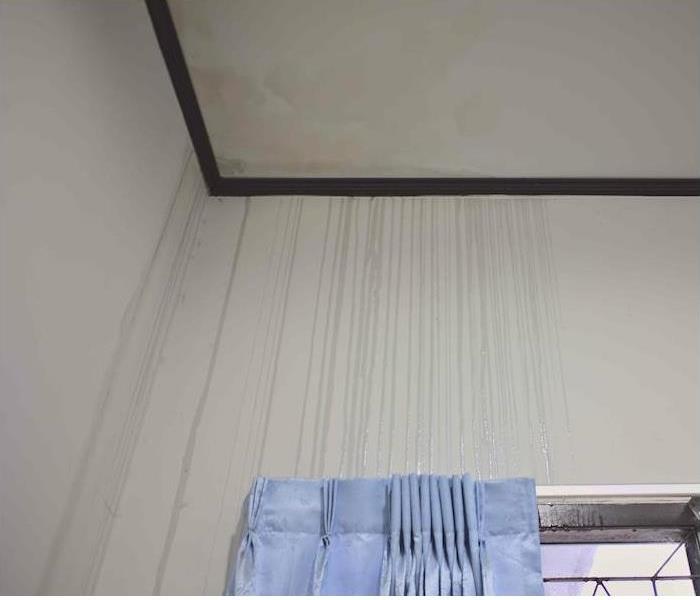 A water leak can turn into a big problem. Contact the SERVPRO of West Kirkwood/Sunset Hills team if you are dealing with any water damage.
A water leak can turn into a big problem. Contact the SERVPRO of West Kirkwood/Sunset Hills team if you are dealing with any water damage.
Chances are good you didn’t wake up this morning with your fingers crossed, hoping you’d get to deal with a burst pipe or water running down your wall. Let’s be real—nobody wants to deal with water leaks, but as homeowners, sometimes we get no choice.
If you’re vigilant, however, you may be able to spot warning signs, or make necessary updates before aging pipes wear down. Here are a few places to keep your eyes on.
Toilets. Your toilet always has water running in and through various seals and tubes, and over time, it’s prone to develop leaks, particularly in the flapper or the valve seal, which are inexpensive and simple to replace.
Appliances. You likely have several appliances that use water hoses—dishwashers and refrigerators often develop leaky water supply lines—and traditional tank-style water heaters have been know to explode when they get over about 10 years old.
Clogged gutters. Shimmying up the ladder is inconvenient at best, but it’s a surefire way to prevent clogged gutters. Otherwise, dirt particles, leaves and other debris settle and compact themselves into an impassable dam, which means water finds its way up into and under your roof and trickling down your interior walls.
Roof damage. Your roof takes a beating. It’s the main line of defense against harsh sunshine, rain and hail, but all those things over time cause shingles to break, bow up or otherwise dissipate.
Pipes. Heavy water pressure or any oxidization can cause pipes to crack or fail, sending water spewing everywhere. And it’s not only an indoor threat—you may not even know that tree roots can find their way into the tiniest cracks in a sewer line or outdoor pipe and end up causing a complete blockage.
Blocked garbage disposals or other pipes. Eggshells, coffee grounds, and even rice or pasta can glob up in garbage disposals or soak up enough water to clog your sink drains. And what’s more, if your p-trap joints aren’t secure, the plunging you may have to do to unclog those drains can cause your pipes to separate and release all that water and gunk into your cabinetry or floor.
You can’t foresee every leak, but with an eagle’s eye, you can see some of them coming. Replacing hoses and keeping an eye on these common leak areas can prevent a number of water damage scenarios.
If a water leak erupts into a big problem at home, you’ve got the best team in the business on your side. Contact SERVPRO of West Kirkwood/Sunset Hills - 314-858-1688 so we can get started.
Be Prepared: Locate Your Water Shut Off Valve
2/4/2021 (Permalink)
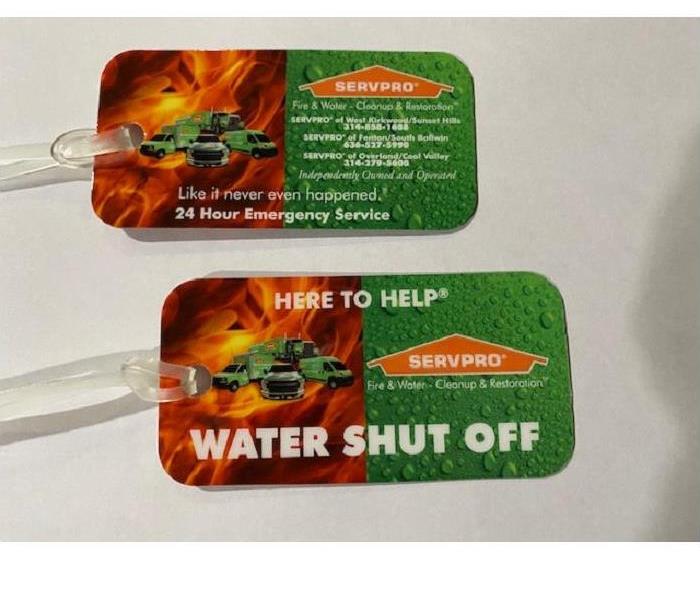 Be Prepared BEFORE a Disaster Strikes!!
Be Prepared BEFORE a Disaster Strikes!!
Water gushing uncontrollably through your house or business is hazardous, unsafe, and will quickly cause major flood damage. If that water is coming from your home's own water supply, and not from outside sources, you can and should shut it down very fast. NOW is the time to locate your Water Shut Off Valve. Once found, make this known to all family members as they may be home alone when disaster strikes! Our office offers FREE Shut Off Tags that you can place as a reminder to all. The quicker the water supply is shut off the less damage to your home or business.
Three Ways to Quickly Locate the Water Shut Off Valve
Find the Water Shut Off Valve on the Inside Perimeter
The first step is to physically search for your house's main water shut off valve on the inside of the home. Typically, it will be located on the perimeter of the house since that is where the water first enters your house. Also, stay on the side of the house that is facing the street. Your water main begins at the street and heads in a straight line to your home. When you find the valve, turn the handle or knife-style valve.
Find the Shut Off Valve on Your Property Inspection Report
If you still cannot find the cut off valve after physically searching for it, one alternative is to check the property inspection report that was completed for you when you were in the final phases of purchasing your home. Look in the plumbing section of the report. This section should locate the shut-off valve for you and have a photo of the valve. Even if the water system was not defective at the time of the property inspection report, the report should still note the locate the shut-off valve as a matter of course.
Find the StreetSide Shut Off Valve
If the previous methods fail, there is another valve located at the beginning of your water main, at the boundary line of your property and the street or sidewalk. Find the ground-level metal or plastic utility box trap door located at ground level. Call the water company's 24-hour emergency contact line. Staff may direct you to shut off the valve by yourself or to wait for an emergency dispatch team.
Call our office at 314-858-1688 or email us at office@sevprokirkwood.com to request your FREE Shut Off Tag!!! #SERVPROKIRKWOODSUNSETHILLS
Frozen Pipes
2/3/2021 (Permalink)
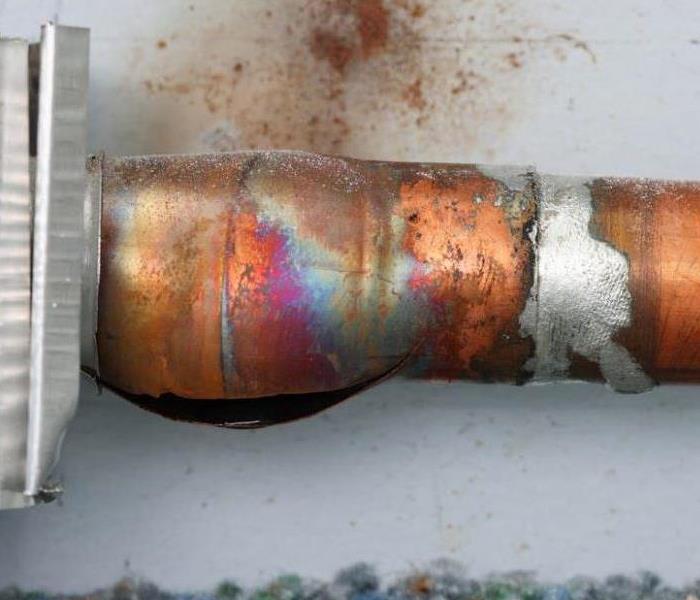 Be prepared!! As much as a couple hundred gallons of water can spill into your home or business with a couple hours , leading to extensive damage.
Be prepared!! As much as a couple hundred gallons of water can spill into your home or business with a couple hours , leading to extensive damage.
Bursting water pipes are a major concern when winter temperatures drop below freezing. But why do frozen pipes burst?
Perhaps surprisingly, freezing pipes do not burst because of ice expanding in place. Instead, it has to do with pressure inside the pipes.
When water freezes, its molecules crystalize into an open hexagonal form, which takes up more space than when the molecules are in their liquid form — that is, the water molecules expand as they freeze.
As the ice expands, it pushes water toward the closed faucet. This causes an immense amount of water pressure to build between the ice blockage and the faucet — eventually, the pipe ruptures under the pressure, usually at a spot where there is little or no ice.
The pipe areas upstream of the ice clog are not typically in danger of bursting because the pressure is not great enough. In this case, the water is not blocked, and can always retreat to its source.
Pipes that are the most at risk of bursting are those located outside of building insulation, or those in unheated interior areas, including basements, attics, and crawl spaces.
Heating or insulating these vulnerable pipes with fiberglass or foam sleeves can help prevent them from bursting. Additionally, keeping the facet open and letting the water run, even at just a trickle, will help prevent the water pressure from building to dangerous levels.
Prepare your home or business before the bitterly cold temperatures arrive!!
What's Safe to Flush or Drain?
5/12/2020 (Permalink)
What’s Safe to Flush or Drain?
Disposing of the wrong items in a toilet or drain can cause blockages and slow drainage, flooding, and hazardous sewage back-ups into your home or yard. Fixing them can require costly and disruptive repairs for you and contributes to sewer rate increases for the whole community. Don’t let your hard-earned money go down the drain. Follow these guidelines at home and work.
The sewer pipes that serve the toilet, shower, bath, sinks, washing machine, and floor drains in your home or business are designed to carry only three things: human body waste, toilet paper, and wastewater. When other items are put down the drain, they can combine to cause clogs, put additional stress on the pipes, or get caught up in our wastewater treatment facilities. This material then needs to be trucked to a landfill, causing extra work and expense, and higher rates for customers.
Don't Flush or Drain (Just to name a few!)
- Bones
- Bread Dough
- Butter
- Coffee Grounds
- Eggshells
- Gravy
- Paper Towels
- Rubber Bands
- Tampons
- Wet Wipes
DO:
- Place a wastebasket in your bathroom for disposing non-flushable items.
- Place liquid cooking fats, oil and grease into a container with a lid and dispose of in trash.
- Wipe down greasy pots, pans and dishes before washing.
- Have your sewer rodded or snaked regularly.
- Dispose of old medicines or drugs at an approved drug take-back site or event.
- Dispose of motor oil, paint, grease or other dangerous fluids at the St. Louis Household Hazardous Waste collection facility.
If your home or business sustains a backup we are here to help 24/7/365 days!!! Call SERVPRO of West Kirkwood/Sunset Hills 314-858-1688
The Science of Drying
5/5/2020 (Permalink)
Did you know there is a science behind the process of drying? Having the knowledge of psychrometrics is essential to restoring a water-damaged structure to its preloss condition. While your initial reaction may be to grab a few towels to mop up the mess and place a fan or two around the damaged area, SERVPRO of West Kirkwood/Sunset Hills Franchise Professionals are trained in the science of drying and follow strict industry-approved standards to help lower the chances of any secondary damages. If your business suffers a water damage, SERVPRO Franchise Professionals will:
- Inspect the building to detect every component that is wet to help prevent secondary damage from happening.
- Measure how much moisture is in wet materials and monitor whether the materials are drying properly.
- Speed up Mother Nature by using professional drying equipment.
What exactly does it mean to help "Speed up Mother Nature"? A wet building can often dry naturally because the environment always seeks equilibrium. When materials are wet, moisture will naturally move to drier air at the surface of the material - but only if the air is, indeed, drier.
The only problem is nature often takes too long and secondary damages may occur while the building is drying out.
Your SERVPRO professionals have the tools and equipment to help Mother Nature along, including equipment to help dry hardwood floors, tough-to-reach spaces inside walls, and much more.
It's not only the equipment, but the technology too. SERVPRO had developed DryBook, a proprietary tool that provides real-time documentation and updates on the drying process and helps ensure industry drying requirements are met. With DryBook Mobile, you can know exactly where your property is in the drying process.
Bottom line, SERVPRO of West Kirkwood/Sunset Hills Franchise Professionals have the training and equipment to help make water damage "Like it never even happened."
We are always here to help! 314-858-1688
Managing Mold
4/30/2020 (Permalink)
When there is a water intrusion, like a roof leak or leaking water line, mold can quickly become a problem in your home or business. Mold can cause health effects and can also cause significant damage to your property. Fortunately, here at SERPVRO of West Kirkwood/Sunset Hills, we have the training, protective gear, and specialized equipment necessary to handle your mold problem. Although every mold damage scenario is different requiring a unique solution, the general mold remediation process stays the same.
- Call the team at SERVPRO of West Kirkwood/Sunset Hills
- Your property will be carefully inspected for signs of mold using technology designed to detect to detect mold and hidden water sources.
- Various containment procedures will be placed to prevent the spread of mold and isolate the contaminated area with physical barriers and negative air pressure to keep the mold spores from spreading during the cleanup process.
- Specialized filtration equipment captures microscopic mold spores out of the air.
- The mold remediation process depends on the amount of mold growth and the types of surfaces on which the mold appears. Removing and disposing of mold-infested porous materials, like drywall and flooring, may be necessary.
- A variety of cleaning techniques will be used to clean and sanitize your belongings.
SERVPRO of West Kirkwood/Sunset Hills understands mold and mold growth and have the training and equipment to remediate mold in your home or business, so give us a call! 314-858-1688
Toilet Overflow
4/28/2020 (Permalink)
Basic toilet design and function has not changed much in almost a century. Most modern toilets are still simple, efficient devices, but they do require periodic preventive maintenance and repair. If your toilet overflows, it can be much more than a mere nuisance -- if you don't give it immediate attention, it can cause extensive and costly damage. Although serious repairs should be performed by a professional plumber, most preventive maintenance and repairs, including fixing a toilet overflow problem, can typically be performed by the homeowner.
Common Causes of Toilet Overflows
- The most common cause of a toilet overflow is a blockage within the toilet or connecting waste pipes. Once a blockage occurs, subsequent flushing will cause an overflow condition. A blockage could be the result of excessive use of toilet paper or a foreign object being flushed.
- A waste line blockage can cause waste water to back up into your tub or shower as well as overflow your toilet. A dishwasher or washing machine draining could cause an overflow in your toilet if the blockage is in certain locations. A collapsed pipe or penetration by tree or shrubbery roots can cause a blocked main line.
- An insufficient amount of water per flush can cause a blockage because waste will not be completely removed from the toilet or waste line. Additional flushes to clear the bowl can cause an overflow.
- Obstructions in the vent piping can result in slow draining, causing backups and overflows.
Solutions for Toilet Overflows
- A blockage within the toilet can often be dislodged with a toilet plunger. If the toilet plunger does not free the blockage or the blockage is further down, a toilet auger might do the trick.
- For a blockage in the main line, you can rent a plumber's electric snake from most home improvement stores or equipment rental yards.
- To verify that the amount of water is adequate, remove the tank lid and check the water level within the tank. It should be at the water level mark on the inside back of the tank. Adjust it by moving the float up to increase the amount of water in the tank.
Make sure all vent piping is clear of any debris. This may require accessing the roof, so you may want to call a professional plumber if you suspect an obstruction in the vent piping. Homes with septic tanks can also have toilet backups. This can be from the septic tank needing to be pumped out, a blocked drain line or a faulty pump, if applicable. Water-saturated ground near the buried septic tank or a flooded drain field is a sure sign of a problem, according to the U.S. Environmental Protection Agency.
SERVPRO of West Kirkwood/Sunset Hills is available to make it "Like it never even happened." 314-858-1688
When Water Damage Strikes
4/16/2020 (Permalink)
The first 24 hours following a water damage are the most important. This is when you can prevent any secondary or permanent damage from happening. Here are a few emergency tips for your home or business. First, shut off the water source, if you are unable to locate or shut off the source call in a qualified professional to help. Secondly, turn off any circuit breakers for any wet areas. Water and electric do not mix! Third, place aluminum foil or wood blocks under the legs of furniture to prevent staining on carpet and wicking of water up the furniture and relocate any paintings, art, computers, documents, and other valuables to a dry space. Be careful of cross contamination! Start to remove as much excess water by mopping and/or blotting. Lastly, know your water remediation specialists at SERVPRO of West Kirkwood/Sunset Hills is always here to make it ”Like it never even happened.” (314) 858-1688
The Role of Air Movement for Evaporation
3/27/2019 (Permalink)
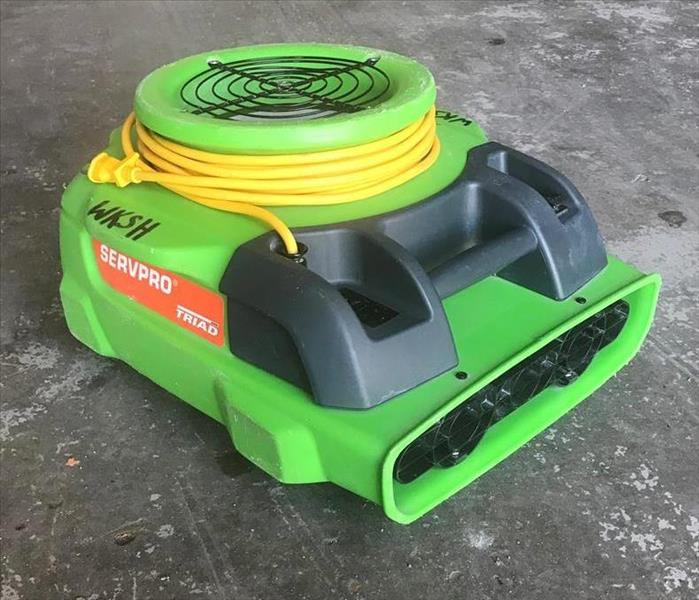 Air Mover
Air Mover
Two aspects of air movement influence evaporation of moisture from materials:
- Velocity - The speed of the air moving across surfaces.
- Volume - The quantity or amount of air moving during a period of time.
Velocity is a multiplier in the evaporation process, multiplying the rate that evaporation occurs. The velocity of airflow is comparable to wind speed. Higher wind speed will result in higher evaporation rates. Likewise, the faster the velocity of air moving over a wet surface, the better the rate of evaporation will be. Velocity is measured in feet per second (FSP), feet per minute (FPM), or miles per hour (MPH), and can be determined using an anemometer.
Volume is critical to the circulation of air. Airflow used for drying must have high wind speed, but that wind must be dry air. The source of dry air usually is a mechanical dehumidifier, though it could also be the outdoor environment. Regardless of the source, the dry air must be distributed or circulated throughout the affected area, much like the heated or cooled air from an HVAC system must be distributed throughout.
Moving air from one location to another is a product of mass, or volume, and is usually expressed in Cubic Feet per Minute (CFM). We measure air movers in terms of CFM to indicate how much air the air mover is able to move around.
Project Managers can better control air movement when they understand the roles of air volume and air velocity. Volume is not velocity. Adequate velocity is critical for increasing the rate of evaporation. Adequate volume is important when trying to circulate warm, dry air throughout especially large and complex structures.
What to expect from the Initial Water Damage Inspection?
3/26/2019 (Permalink)
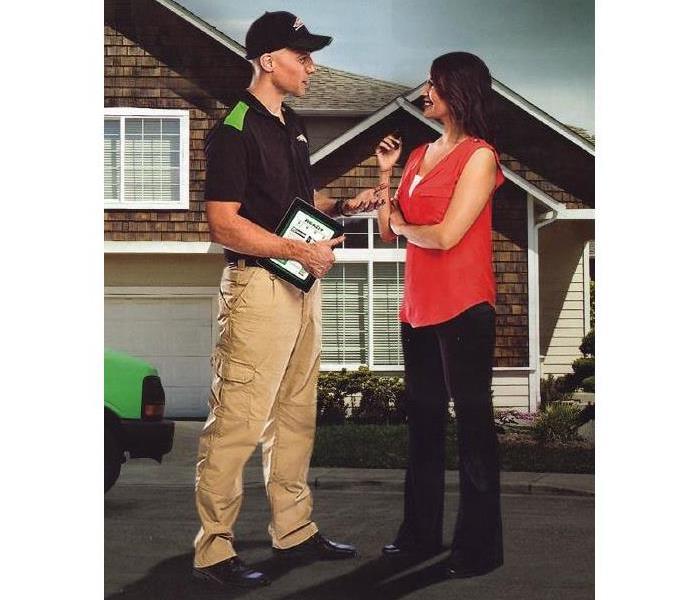 Loss Professional completing an Initial Inspection for a water damage.
Loss Professional completing an Initial Inspection for a water damage.
The goal of the restoration process is to transform an abnormally wet, potentially damaged structure into an environment of equal or better appearance and cleanliness than before the intrusion occurred, and to do so in the most economical and efficient means possible.
Our Loss Professionals begin this process by identifying all affected materials. Water must be tracked from its source and followed in every direction to establish an accurate perimeter of the flooded area. Next, our Loss Professional documents what types of materials have been affected (e.g., type of subflooring, type of carpet and underlay, type of wall construction, and type of insulation.) Affected materials are then evaluated against three criteria to determine if they should be restored or replaced.
The 3 Criteria are:
- Degree of Contamination
- Damage to the item
- Replacement cost vs. Restoration cost
Only after identifying the material and considering these three factors does the Loss Professional decide which materials should be dried and which should be replaced. In addition, the Loss Professional will also decide which materials should be dried aggressively and which should be dried through more disruptive means.
Why we Monitor on a daily basis
3/26/2019 (Permalink)
Drying progress is noted during daily monitoring visits. The Project Manager asks "Is it drying?" while comparing the moisture readings taken from two separate monitoring visits. These two sets of data, recorded in DryBook, reflect the impact of the drying effort on the affected materials over a 24-hour period.
If materials are making significant progress after the initial 24-hours of drying, then drying continues; no major change is necessary to the process. Our Project Manager continues to observe progress until drying is complete.
If materials are not drying, it is clear that the current approach is not working. The Project Manager must re-evaluate the equipment, systems and processes and refine our approach. The approach can be more aggressive, or more disruptive. The evaluation process is identical to the initial assessment except in one important detail. Now the material has been wet for an additional 24 hours. Damage and contamination are of greater concern.
This cycle of evaluation and re-evaluation must continue throughout the restoration project. The critical element to the process is that drying progress must be constant. If the drying process is not working, the Project Manager must modify the drying environment by adding or subtracting equipment or possibly removing wet, non-salvageable materials. The most economical and effective methods are best identified by a consistent focus on contamination, damage and cost.
Primary and Secondary Damage following a Water Damage
3/26/2019 (Permalink)
Water intrusions will affect building materials both immediately and over time. Damage that occurs immediately by direct contact with water is referred to as primary damage. Damage that occurs because material remains wet for an extended period of time is referred to as secondary damage.
Water also affects materials indirectly. Excessive moisture leads to elevated humidity. Many building materials will absorb excess water vapor and suffer damage, especially when the air in the structure is allowed to remain above 60% relative humidity. This form of damage from high humidity is also referred to as secondary damage. Secondary damage includes dimensional changes, loss of structural integrity, microbial growth and staining.
Hygroscopic materials absorb moisture easily, whether from direct contact with water or from exposure to high humidity. As a result, hygroscopic materials are very susceptible to secondary damage. Such materials gain and lose moisture continually in an effort to equalize with the water content in the surrounding air. The more hygroscopic the material, the faster it will collect water vapor, and the easier it will suffer secondary damage.
Extraction: Remove the Easy Water First
3/26/2019 (Permalink)
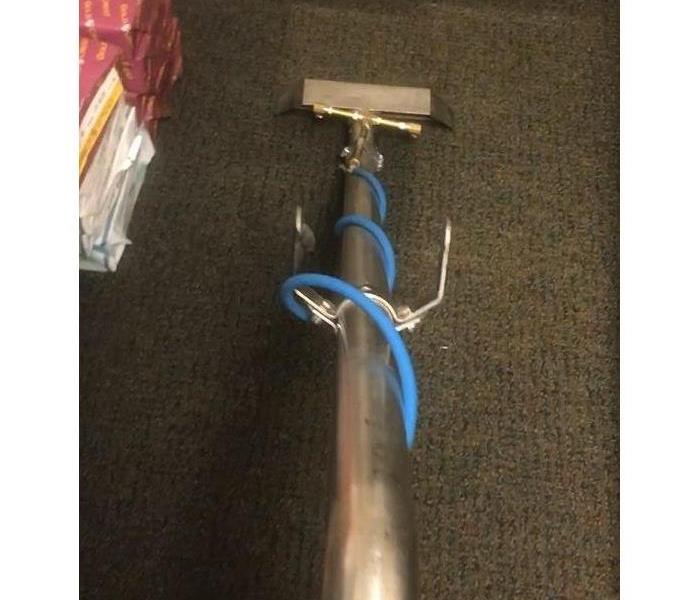 Portable Extraction Wand to remove excess water.
Portable Extraction Wand to remove excess water.
The most effective way to speed the drying process is to remove as much of the water in a liquid state as possible during the extraction phase of the restoration project. Poor extraction will significantly slow the drying process.
Extraction and evaporation are the only ways water can be removed from a wet structure. During the extraction process, liquid water is extracted, mopped, squeegeed or otherwise removed from the structure. This takes some energy, but not nearly as much as evaporation.
The most important factor in extraction is not how much water is removed, but how much water is left behind. It is important to remember that every drop of water left behind will add time to the drying project.
The two-step process for carpet and pad extraction:
- The primary goal of the initial extraction of the affected area is to contain further migration of the water within the structure. This step is accomplished using a light wand attached to either a portable or truck mounted extraction unit.
- The deep extraction process is accomplished by using a sealed or weighted extraction tool attached to either a portable or truck mounted extraction unit.
If deep extraction is not available, the carpet pad must be removed to prevent lengthy drying times. Otherwise, excess water will remain in the carpet underlay. This water must be removed through evaporation, which prolongs the drying process. It also increases the amount of equipment required to meet drying timelines and drastically increases the likelihood of secondary damage to the structure and its contents.
Understanding Water Types
3/11/2019 (Permalink)
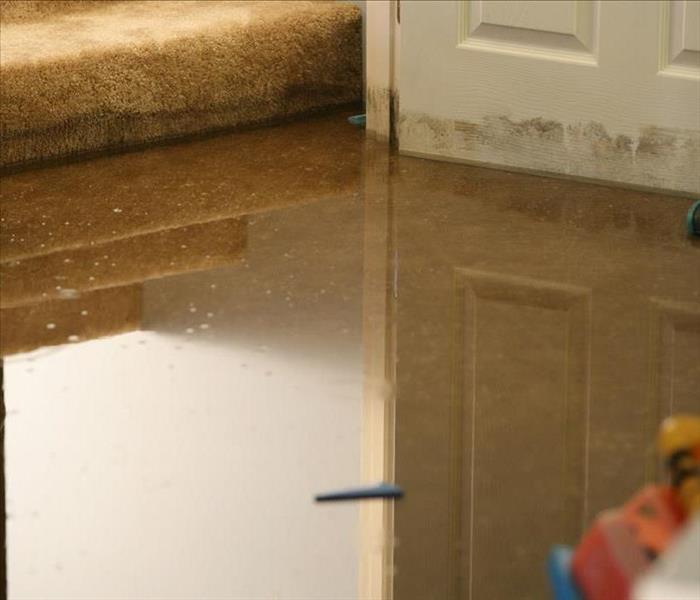 Where did the water come from?
Where did the water come from?
When your home or business suffers a water damage, understanding what type of water you are dealing with is critical to ensuring proper cleanup.
There are 3 classification of water types.
Clean water is water from a broken pipe, or other water source; rainwater is considered clean until it touches the ground or other surfaces.
Grey water is used to classify slightly contaminated water. Clean water becomes gray water when it is left untreated allowing bacteria and other contaminants to begin growing, making the water hazardous.
Black water is typically caused by sewage damage, flooding or any type of natural disaster. Black water should always be handled by trained professionals.
We encourage all our customers to take the following precautions to help minimize damage or prevent further damage while waiting for help to arrive.
Damage from Clean Water:
-Shut off the water source if possible or contact a qualified professional to do so.
-Turn off circuit breakers for wet areas of the building if access to the power distribution panel is safe from potential electrical shock. Do NOT enter rooms with standing water.
-Remove as much excess water as possible by mopping and blotting.
-Remove and prop up wet upholstery cushions to allow more even drying.
-Move any paintings, art objects, electronics, documents and other valuable items that may be sensitive to moisture to a safe place.
-Do not leave books, newspapers, magazines or other colored items on wet carpets or floors as they may cause staining.
-Do not use your household vacuum cleaner to remove water as there is potential for electrical shock or causing damage to the cleaner.
-Do not turn on ceiling fixtures if ceiling is wet; do not enter rooms where ceilings are sagging from retained water.
Damage from Contaminated Water:
-Avoid all contact with sewage and items contaminated by sewage. Wash your hands thoroughly if you come in contact with contaminated items.
-Do not walk through contaminated areas, as you could spread damage to unaffected areas.
-Do not turn on the HVAC system if there is a possibility of spreading contaminated air.
-Do not use household fans to dry the structure; air flow could spread contaminants.
-Discard any food and/or products for personal hygiene if exposes to the contaminated areas.
If you sustain a water damage call SERVPRO of West Kirkwood/Sunset Hills, 24/7/365, at 314-858-1688. We are always here to help!!!
Busted Pipe in St. Louis, Mo
3/15/2018 (Permalink)
This water damage was cause by a busted pipe running to a spigot affected most of a finished basement. Our professional crews here at SERVPRO West Kirkwood and Sunset Hills had to extract standing water and remove some carpeting. The crews also had to cut affected walls at 2 ft. and spray affected areas with sporicidin. Spraying sporicidin on the affected contents reduces microbial growth. The homeowners were very please with how quick and thorough our crews were to their home and all of their stuff throughout the home. The family was grateful to have their home back to normal after 4 days! In many cleaning and restoration situations, immediate action is needed. Water is particularly invasive, quickly spreading throughout your property and being absorbed into floors, walls, furniture, etc. SERVPRO of West Kirkwood and Sunset Hills arrives quickly and starts the water extraction process almost immediately. For help restoring your home or business after a water loss, call SERVPRO of West Kirkwood and Sunset Hills at 314-858-1688 and we’ll make it “Like it never eve happened.”
Frequently Asked Questions About Water Damage!
2/16/2018 (Permalink)
Whether a person has been the victim of water damage or is just researching for information on some of the mitigation steps he can take, there may be a number of questions he might have. In this regard, such a person might want to get as much information as possible. There are many avenues where he can get the information on water cleanup, restoration, and mitigation services. However, the best option is to ensure that he is getting the advice from professionals with a wide range of experience in handling water damage restoration. Still, providing readers with some answers to the commonly asked questions can help to save them the trouble.
What causes flood damage?
There are various factors that can lead to water damage. A supply line break can occasion a leak that floods the house. A pipe break or a blockage in the sewer system can also contribute to water damage. There are also some accidents such as forgetting to properly close the taps, rain storms, among others that can lead to a flooded home. If the home is left unattended for some time, it may give an appearance of drying, but this might only mean that the water has seeped deep into the floor and walls and is causing internal damage. This is especially the case if the supply line break occurs in an area that is not accessed regularly such as the basement.
What are the dangers of flood damage?
The most dangerous thing about water in the home is letting it stay. If the water cleanup does not take place immediately, the water in the business causes more havoc. It starts to soak into the surfaces that it comes across. This means that if the house or business place has wooden floors, it seeps deep into the wood weakening the structures. It also increases the risk of mold developing. The last thing a home owner wants after flood damage is a mold infestation. This can result in the compromise of the structural integrity of the house. Thus, a flooded home needs immediate drying.
What is the first step after getting a flooded home?
Calling in a professional restoration company should always be the first step. These are professionals that possess not only the know how to handle water cleanup, but also the equipment. They can carry out an assessment of water in business and advice on what needs to be done for restoration. If they are consulted early on, they can also provide mitigation advice to reduce the risk of suffering flood damage.
What is to be done after a pipe break?
If there is a noticeable leak from a pipe break or supply line break, the first step is to try and see if the leakage can be stopped. This would entail closing the mains supply of water in the home. If there is some water in the home, then the electrical supply should be switched off. This would help to minimize the risk of damaging the appliances. The restoration company should then be called in to assess the extent of water in business.
Is water damage covered by homeowners insurance?
There are certain instances when insurance can cover damage occasioned by water in the home. These may include an accidental and immediate pipe break or supply line break. However, flood damage is not usually covered by insurance. The damage brought on by a flooded home would fall under the category of “Act of God,” something not insured. Thus, the homeowner should inform the restoration company of any insurance coverage so that they can determine whether the water cleanup would be covered. The insurance may cover the costs of drying the home.
What does the restoration company do?
Once the professionals from the restoration company get to the site of the water cleanup, they carry out an assessment. The best professionals provide upfront pricing on the water cleanup, drying, and restoration services to be provided. They also provide mitigation services which are important in ensuring that incidences of water in business do not occur often.
Visit: http://www.SERVPROwestkirkwoodsunsethills.com for more information on water damage.
Ice Dam Protection and Prevention Tips for your West Kirkwood/Sunset Hills Home
1/10/2018 (Permalink)
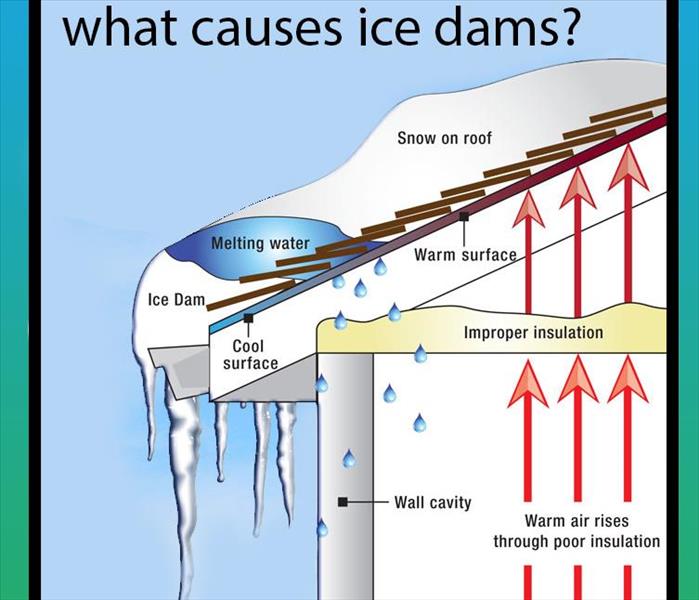 This photo shows you what causes ice dams.
This photo shows you what causes ice dams.
What are Ice Dams?? You know those beautiful icicles hanging down from your gutter after it rains or snows? Well those beautiful things are formed from the ice dams! Ice-dam situations have two things in common: They happen because melting snow pools behind dams of ice at the roof’s edge and leaks into the house; also, ice dams and the damage that results from them is avoidable. Three things are required for an ice dam to form: snow, heat to melt the snow and cold to refreeze the melted snow into solid ice. Ice damn can happen with as little as one inch of snow on your home or business’ roof! Water runs down the roof slope under the blanket of snow and refreezes into a band of ice at the roof’s edge creating a “dam”.
So how can you prevent your Kirkwood and Sunset hills home from getting Ice Dams and the damage that comes along with them! Having proper insulation and roof ventilation is the key to an ice dam free house!
Water-stained ceilings, dislodged roof shingles, sagging ice-filled gutters, peeling paint, and damaged plaster are all easily recognized and usually repaired when weather or budgets permit. But other damage is not as obvious and often goes unchecked. The more heat lost – the more ice dams form – the more it leaks – the more the insulation gets damaged – and so on and so forth.
If you have ice dam damage and need help restoring your home or business give SERVPRO West Kirkwood and Sunset Hills a call at 314-858-1688 and well make it “Like it never even happened.”
Why Water Damage is NOT a DIY Project
3/17/2017 (Permalink)
Oftentimes, homeowners don't realize the extent of the water damage in their home. Excess moisture is one thing, but damage from a flood, sewer backup or something else can be devastating to your health and your home in general. It doesn't take long for a situation like this to spiral out of control and leave you struggling to figure out what you are going to do to take care of it. The best thing you can do is turn to the help of a professional. Our team at SERVPRO West Kirkwood has all of the necessary tools to make sure your home is taken care of and the water damage is cleaned up properly.
- Dirty water from sewage backups is loaded with deadly substances from parasites to chemical residues.
- Bacteria, fungi and viruses thrive in contaminated fluids. They pose all sorts of health risks, such as hepatitis and salmonella.
- It only takes 24 hours for mold to begin growing out of control and invading your space.
- Even a small amount of water left undried could be a source of problems for your home.
Our team here at SERVPRO West Kirkwood has all of the necessary tools and experience to come in and get your water damage taken care of and thoroughly cleaned up to prevent anyone from falling ill or mold setting in.
HOW SEVERE LOOK HERE!
3/13/2017 (Permalink)
Water damage can originate by different sources such as a broken dishwasher hose, a washing machine overflow, a dishwasher leakage, broken/leaking pipes, and clogged toilets. Homeowners should inspect and replace worn pipe fittings and hose connections to all household appliances that use water at least once a year. This includes washing machines, dishwashers, kitchen sinks and bathroom lavatories, refrigerator ice makers, water softeners and humidifiers. Below is a specific way SERVPRO has combined different scenarios of water damages of how severe the damage actually is.
Categories
Category 1 Water - Refers to a source of water that does not pose substantial threat to humans and classified as "Clean Water". Examples are broken water supply lines, tub or sink overflows or appliance malfunctions that involves water supply lines.
Category 2 Water - Refers to a source of water that contains a significant degree of chemical, biological or physical contaminants and causes discomfort or sickness when consumed or even exposed to. Known as "Grey Water". This type carries micro organisms and nutrients of micro organisms. Examples are toilet bowls with urine (no feces), sump pump failures, seepage due to hydrostatic failure and water discharge from dishwashers or washing machines.
Category 3 Water - Known as "Black Water" and is grossly unsanitary. This water contains unsanitary agents, harmful bacteria and fungi, causing severe discomfort or sickness. Type 3 category are contaminated water sources that affects the indoor environment. This category includes water sources from sewage, seawater, rising water from rivers or streams, ground surface water or standing water. Category 2 Water or Grey Water that is not promptly removed from the structure and or have remained stagnant may be re classified as Category 3 Water. Toilet back flows that originates from beyond the toilet trap is considered black water contamination regardless of visible content or color.
Classes
Class of water damage is determined by the probable rate of evaporation based on the type of materials affected, or wet, in the room or space that was flooded. Determining the class of water damage is an important first step, and will determine the amount and type of equipment utilized to dry-down the structure.
Class 1 - Slow Rate of Evaporation. Affects only a portion of a room. Materials have a low permanence/porosity. Minimum moisture is absorbed by the materials.
Class 2 - Fast Rate of Evaporation. Water affects the entire room of carpet and cushion. May have wicked up the walls, but not more than 24 inches.
Class 3 - Fastest Rate of Evaporation. Water generally comes from overhead, affecting the entire area; walls, ceilings, insulation, carpet, cushion, etc.
Class 4 - Specialty Drying Situations. Involves materials with a very low permanence/porosity, such as hardwood floors, concrete, crawlspaces, plaster, etc. Drying generally requires very low specific humidity to accomplish drying.
Restoration
Different removal methods and measures are used depending on the category of water. Due to the destructive nature of water, chosen restoration methods also depend heavily on the amount of water, and on the amount of time the water has remained stagnant. For example, as long as carpet has not been wet for longer than 48 hours, and the water involved was not sewage based, a carpet can usually be saved; however, if the water has soaked for longer, then the carpet is probably irreparable and will have to be replaced.
Here at SERVPRO West Kirkwood we have a highly skilled team who can clean up any amount of water in your home or business. SERVPRO West Kirkwood is open 24/7/365 so give us a call anytime at 314-858-1688.
Water Damage Timeline
2/15/2017 (Permalink)
Have you ever had your toilet over flow, or spill a lot of water on your floors and didn't notice until later how much water got on the floors? Well, not properly cleaning spilt water on your floors right away can cause serious problems. Check out the water damage timeline below and see what happens in minutes, hours and even weeks!
Within Minutes:
Water quickly spreads throughout your property, saturating everything in its path.
Water is absorbed into walls, floors, upholstery, and belongings.
Furniture finishes may bleed, causing permanent staining on carpets.
Photographs, books, and other paper goods start to swell and warp.
Hours 1 - 24:
Drywall begins to swell and break down.
Metal surfaces begin to tarnish.
Furniture begins to swell and crack.
Dyes and inks from cloth and paper goods spread and stain.
A musty odor appears.
48 Hours to 1 Week:
Mold and mildew may grow and spread.
Doors, windows, and studs swell and warp.
Metal begins to rust and corrode.
Furniture warps and shows signs of mold.
Paint begins to blister.
Wood flooring swells and warps.
Serious biohazard contamination is possible.
More Than 1 Week:
Restoration time and cost increase dramatically; replacing contaminated materials and structural rebuilding may be extensive.
Structural safety, mold growth, and biohazard contaminants pose serious risks to occupants.
Our team at SERVPRO west Kirkwood has all of the necessary tools and experience to come in and get your water damage taken care of and thoroughly cleaned up to prevent anyone from falling ill or mold setting in. Give us a call at 314-858-1688 and we'll make it like it never happened!
We offer 24/7 water damage mitigation!
10/24/2016 (Permalink)
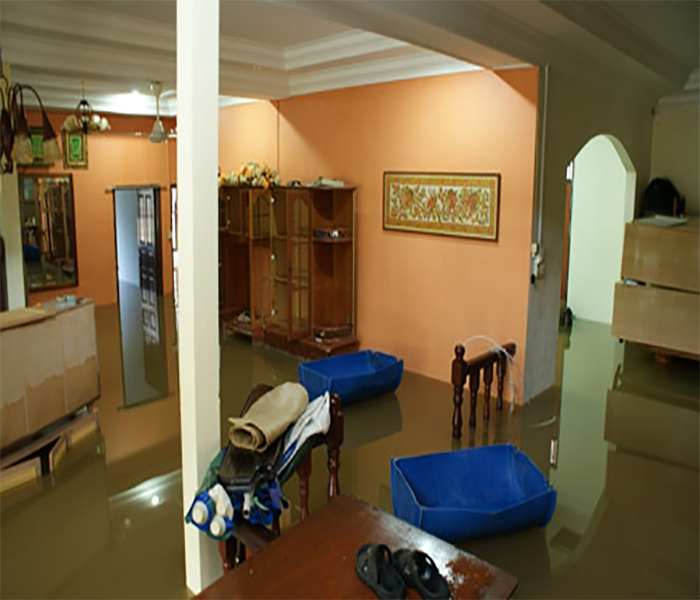 Has this happened to you? Call us at 314-858-1688 - we're here to help!
Has this happened to you? Call us at 314-858-1688 - we're here to help!
SERVPRO of West Kirkwood/Sunset Hills is available 24 hours a day for water emergencies, large or small. When you are dealing with water damage, immediate action is crucial. A delay of just a few hours can greatly increase the severity of the water damage.
We Answer the Phone Ready to Help
Call Today - 314-858-1688
We understand that when you call us, you may be feeling confused, stressed, and vulnerable. You need an expert to guide you through this crisis. SERVPRO of West Kirkwood/Sunset Hills has the specific water damage training and experience to help you through this tough time. We specialize in water damage restoration—in fact, it's the cornerstone of our business.
What to Expect
When you call, we will ask several questions regarding your water damage emergency. These questions will help us determine what equipment and resources to bring, including how many trained SERVPRO Professionals may be needed.
Our SERVPRO Representative will ask several questions:
- Your name and contact information
- Your insurance information (if applicable)
- The street address of the water-damaged home or business
- When did the flooding or water damage occur?
- What caused the water damage (if known)?
- Is there electricity available (on-site)?
About SERVPRO of West Kirkwood/Sunset Hills
SERVPRO of West Kirkwood/Sunset Hills specializes in the cleanup and restoration of residential and commercial property after a fire, smoke or water damage event. Our staff is highly trained in property damage restoration. From initial and ongoing training at SERVPRO’s corporate training facility to regular IICRC-industry certification, rest assured our staff is equipped with the knowledge to restore your property. We have over 12 years' experience in water damage restoration in the West Kirkwood/Sunset Hills area - from large commercial losses to flooded homes, WE DO IT ALL!
 SERVPRO of West Kirkwood/Sunset Hills is your local commercial water restoration company. We will always be here to help and get you back in business.
SERVPRO of West Kirkwood/Sunset Hills is your local commercial water restoration company. We will always be here to help and get you back in business.





 24/7 Emergency Service
24/7 Emergency Service




